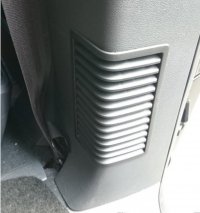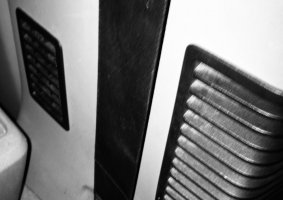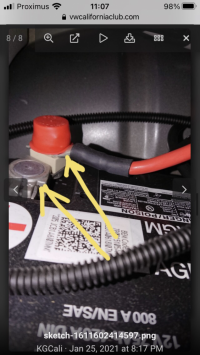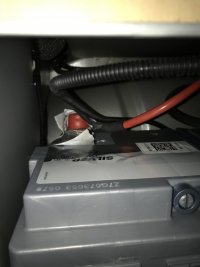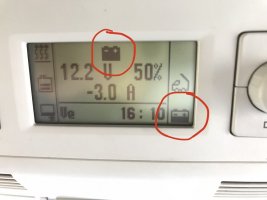laeli
VIP Member
Hello everybody, I just got myself a second hand T5 (2007) and I’m puzzled by the Webasto aux heating. I have read all posts about the earth shunt issue, but before claiming I have a problem I would like to better understand what would be considered “normal operation” as I lack a reference. I would appreciate if someone with a good functioning heater could share some voltage values/drain of their equipment when operating for hours.
Mine starts with large battery drain (I understand that this is normal), runs for 6-7h and then turns off. Completely, no light on the symbol in the control unit, neither red nor yellow.
Last weekend I took a picture when it stopped, it showed 12.2V and 40%. Fuel was above half, so plenty of it.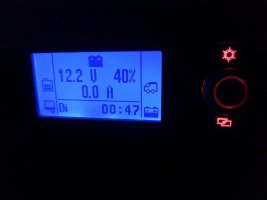 Problem is that with this % it won’t kick off again, when I tried, the battery dropped to 10% (I didn’t take a picture, I think voltage was showing 11.8V) and, after few moments of clicking sounds, the whole system switches off again. I need to start the engine, just 5-10 minutes running, then the battery is showing 100% and I can immediately restart the heater. Note I only keep level 1-2 when it runs as it is warm enough.
Problem is that with this % it won’t kick off again, when I tried, the battery dropped to 10% (I didn’t take a picture, I think voltage was showing 11.8V) and, after few moments of clicking sounds, the whole system switches off again. I need to start the engine, just 5-10 minutes running, then the battery is showing 100% and I can immediately restart the heater. Note I only keep level 1-2 when it runs as it is warm enough.
Is this its normal way of working? Just 6-7h of hot air, so less than a night sleep? Is it normal that it stops at 12.2V?
Second question: I watched during (seemingly) proper functioning, some time after starting it with engine on, and there’s always a constant consumption of around -4.2A.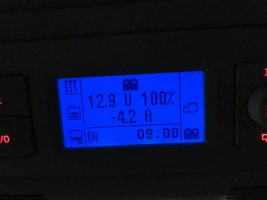 Nothing else is on, no fridge, no lights, nothing plugged. Why is that? I thought that after starting it should just run on diesel, not the battery. Is this due to the fan of the webasto? Is -4.2A a normal value? (Then no surprise the battery drops to insufficient level in 6-7h I guess....)
Nothing else is on, no fridge, no lights, nothing plugged. Why is that? I thought that after starting it should just run on diesel, not the battery. Is this due to the fan of the webasto? Is -4.2A a normal value? (Then no surprise the battery drops to insufficient level in 6-7h I guess....)
Any tips to get it running longer are appreciated. Anything else I should check? (note both leisure batteries were recently replaced, they’re not as old as the van!)
Thank you very much.
Elisa
Mine starts with large battery drain (I understand that this is normal), runs for 6-7h and then turns off. Completely, no light on the symbol in the control unit, neither red nor yellow.
Last weekend I took a picture when it stopped, it showed 12.2V and 40%. Fuel was above half, so plenty of it.
 Problem is that with this % it won’t kick off again, when I tried, the battery dropped to 10% (I didn’t take a picture, I think voltage was showing 11.8V) and, after few moments of clicking sounds, the whole system switches off again. I need to start the engine, just 5-10 minutes running, then the battery is showing 100% and I can immediately restart the heater. Note I only keep level 1-2 when it runs as it is warm enough.
Problem is that with this % it won’t kick off again, when I tried, the battery dropped to 10% (I didn’t take a picture, I think voltage was showing 11.8V) and, after few moments of clicking sounds, the whole system switches off again. I need to start the engine, just 5-10 minutes running, then the battery is showing 100% and I can immediately restart the heater. Note I only keep level 1-2 when it runs as it is warm enough.Is this its normal way of working? Just 6-7h of hot air, so less than a night sleep? Is it normal that it stops at 12.2V?
Second question: I watched during (seemingly) proper functioning, some time after starting it with engine on, and there’s always a constant consumption of around -4.2A.
 Nothing else is on, no fridge, no lights, nothing plugged. Why is that? I thought that after starting it should just run on diesel, not the battery. Is this due to the fan of the webasto? Is -4.2A a normal value? (Then no surprise the battery drops to insufficient level in 6-7h I guess....)
Nothing else is on, no fridge, no lights, nothing plugged. Why is that? I thought that after starting it should just run on diesel, not the battery. Is this due to the fan of the webasto? Is -4.2A a normal value? (Then no surprise the battery drops to insufficient level in 6-7h I guess....)Any tips to get it running longer are appreciated. Anything else I should check? (note both leisure batteries were recently replaced, they’re not as old as the van!)
Thank you very much.
Elisa




